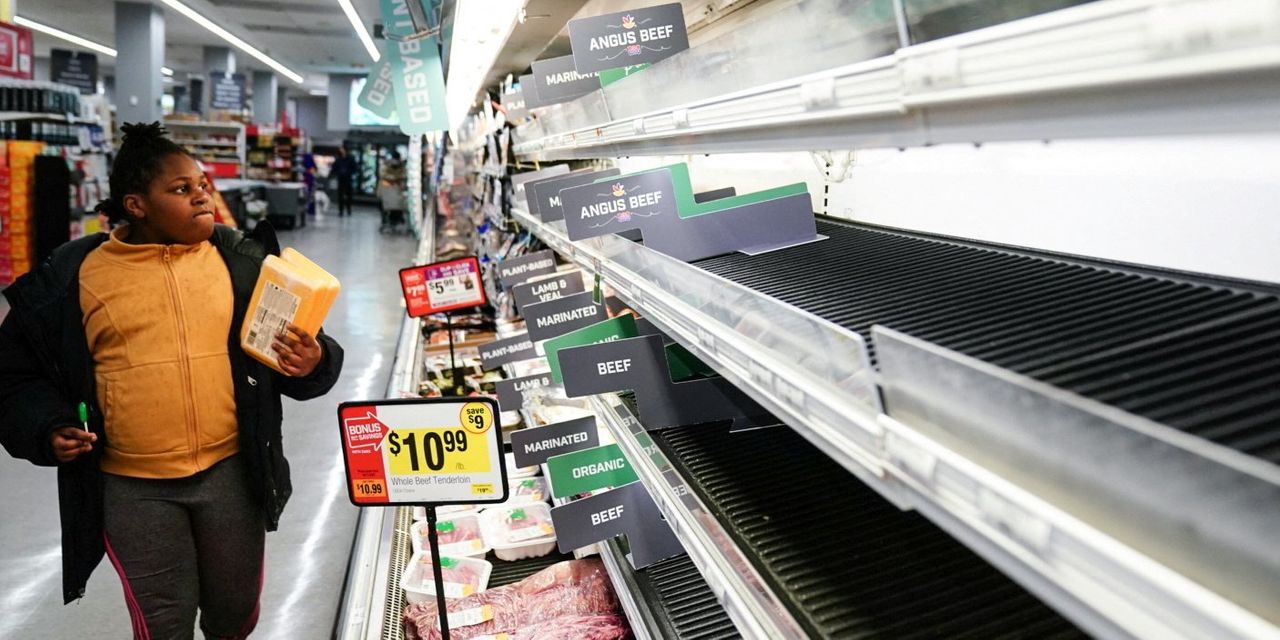
U.S. inflation hit its fastest pace in nearly four decades last year as pandemic-related supply and demand imbalances, along with stimulus intended to shore up the economy, pushed prices up at a 7% annual rate.
The Labor Department said Wednesday the consumer-price index—which measures what consumers pay for goods and services—rose 7% in December from the same month a year earlier, up from 6.8% in November. That was the fastest since 1982 and marked the third straight month in which inflation exceeded 6%.
The so-called core price index, which excludes the often-volatile categories of food and energy, climbed 5.5% in December from a year earlier. That was a bigger increase than November’s 4.9% rise, and the highest rate since 1991.
On a monthly basis, the CPI increased a seasonally adjusted 0.5% in December from the preceding month, decelerating from October and November.
“There is still tremendous momentum when it comes to inflation right now. While inflation is likely to peak in the next few months, the overall pace is going to remain a challenge for consumers, businesses and policy,” said Sarah House, director and senior economist at Wells Fargo.
The last time consumer prices clocked in at such an annual increase was in June 1982, but the circumstances were very different from today. While inflation right now is rising, back then it was falling after peaking at 14.8% in 1980, when Jimmy Carter was still president and the Iranian revolution had pushed up oil prices.
By then, newly installed Federal Reserve Chairman Paul Volcker had set out to crush inflation by raising interest rates dramatically, causing a brief recession in 1980. As rates reached 19% in 1981, a much deeper recession began. By the summer of 1982, both inflation and interest rates were falling sharply.
Today, the Covid-19 pandemic has caused supply-chain disruptions, and a shortage of goods and materials—particularly autos—coupled with strong demand from consumers flush with the benefits of government stimulus are behind the inflation surge.
Prices for autos, furniture and other durable goods continue to drive much of the inflationary surge, fueled by largely pandemic-related imbalances of supply and demand that most economists expect to fade as Covid-19’s impact on economic activity eases. Prices of used cars and trucks soared 37.3% in December from a year earlier, while living room, kitchen and dining room furniture jumped 17.3%.
Economists and the Federal Reserve expect inflation to ease this year as supply bottlenecks clear and demand normalizes, but the Omicron variant of Covid-19 has renewed uncertainty about the economic outlook as the pandemic continues.
Constance Hunter, chief economist at KPMG, expects the booming demand for goods to reverse in the first half of 2022, easing overall price pressure. “I do think we’ll get back to some semblance of normal as people run through their savings and, hopefully, as we move past Omicron,” she said.
Fed Chairman Jerome Powell in congressional testimony Tuesday said he was optimistic supply-chain issues would ease this year and help bring inflation down. However, he also noted that the smaller U.S. labor force “can be an issue going forward for inflation, probably more so than these supply-chain issues,” Mr. Powell said.
The December inflation data suggest a mixed initial impact of the Omicron variant, which is posing a new threat to the economy as the pandemic enters its third year. Prices for airline fares and, in particular, hotels accelerated in December, though those for recreation services fell. Prices for in-person services generally slumped during previous surges in Covid-19 infections.
Gains in energy prices—which had been driven by pandemic-related disruptions as well as by weather and geopolitical factors—showed signs of flagging, with gasoline prices falling 0.5% in December from November. However, food inflation remains elevated, rising 0.5% in December from November, a slightly slower pace than the prior month.
The December employment report signaled continued tightening of the job market, with the unemployment rate dropping to 3.9% from 4.2% in November, the Labor Department said, giving workers additional leverage on pay.
While wages advanced last year at a faster pace than before the pandemic, they didn’t increase enough to keep up with the rise in inflation, with average hourly wages rising 4.7% in December from a year earlier.
“We’re seeing people re-sorting themselves into jobs they’re better suited to or that they prefer. So the wage increases we’re seeing are concentrated in the bottom quintile,” said Ms. Hunter.
Wage increases are contributing increasingly to high inflation because they support higher spending, but also because they raise costs for businesses.
In December, some 49% of small businesses said they planned to raise prices in the next three months, on net, according to the National Federation of Independent Business, a trade association.
Omicron’s uniquely rapid spread has worsened the labor shortage by driving up workplace absences. Manufacturing companies are adopting expensive solutions to keep factories running so they can meet booming demand. FedEx Corp. said this week that Omicron is causing staffing shortages and delaying shipments.
John Merritt, vice president of Elaine Bell Catering in Napa, Calif., said staffing was an immediate issue when demand for weddings and other big events came surging back last June. The company raised wages 50% in a bid to retain workers and hire new ones, but still had to rely on the services of temp agencies. Due to increased labor costs—along with soaring prices for meat, cheese and wheat-based products—the company didn’t make a profit last year, he said.
“People frequently say [restaurant and catering workers] are low-price people. Well, our base pay is now $30 an hour for wait staff and we still can’t fill positions,” he said. “This is going to be an ongoing problem. If we want to have the quality staff for the kinds of events that we do, we know we need to pay for it or we aren’t going to get them.”
The caterer has raised prices for the coming year by 25% to 35% from pre-pandemic rates. So far, customers are accepting the increases. “We’ve never raised prices that much from one year to the next. But we’ve never had cost increases like this either,” said Mr. Merritt.
Demand for furniture and other goods has boomed during the pandemic, straining supply chains and fueling much of the inflation surge. In some industries, scarce materials have hamstrung production. The most prominent example is a shortage of semiconductors that has curbed auto production, sending prices for cars and trucks soaring.
Despite disruptions from Omicron, there are some indications of improvement in supply-chain woes. A December survey of manufacturers by the Institute for Supply Management showed a decline in prices and delivery times, signaling that materials shortages might be easing.
Omair Sharif, founder of Inflation Insights LLC, said he expects used-car and household-furnishing prices to ease further in the coming months as consumers resume spending on services and run down the excess savings amassed during the pandemic.
Economists also expect price pressures from supply constraints to be replaced by higher rent and medical-care costs that tend to be more persistent. Rent, which accounts for nearly one-third of the CPI, has begun accelerating in recent months.
High inflation has prompted some consumers to rein in spending.
Until recently, Pete and Sally McAllister grilled steak every Wednesday evening, but they recently switched to chicken chili because of the high cost of beef.
“The price we were paying [for filet mignon] went from about $12 a pound to over $25. As a result, we’ve cut those meals out of our diet,” said Mr. McAllister, a 72-year-old retiree in Hilton Head, S.C. “The chicken and beans have been a good protein substitute for the beef.”
He said he also has stopped adjusting the thermostat upward because of rising home-heating costs and is going out of his way to find cheaper gasoline. Mr. McAllister said he is golfing less after a number of friends canceled their golf-club memberships to save money. “So there’s kind of a psychic price to inflation too,” he said.
Write to Gwynn Guilford at [email protected]
Copyright ©2022 Dow Jones & Company, Inc. All Rights Reserved. 87990cbe856818d5eddac44c7b1cdeb8








